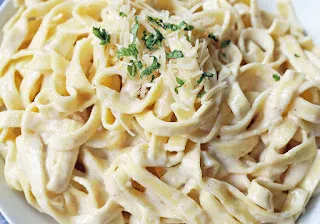The Alfredo's Fettuccine were actually created in Italy but today they are practically unknown in their own country. On the other hand, they became a star dish in Italian restaurants in the United States, and not by chance.
Alfredo di Lelio invented the recipe in his restaurant on Via della Scrofa in 1914. It was probably a variation of other existing buttered pasta dishes, but the customers liked it so much that his wife urged him to make it a regular dish on the restaurant menu. It so happened that two Hollywood silent film artists, Mary Pickford and Douglas Fairbanks, on their honeymoon in Rome, tasted fettuccine Alfredo and were so impressed that they did not hesitate to take themselves a photo in the restaurant that went around the world. Back in Hollywood they took with them the recipe with which they used to gift their guests and from there they were imitated by Italian restaurants throughout America.
As the recipe had not transcended to Italian homes, it gradually fell into oblivion while in the United States it reached a popularity comparable to pizza and pasta. That forgetfulness makes Italians wrinkle their noses at a recipe that seems Italian but is not so in their eyes. However, it is.
The main ingredients in fettuccine Alfredo are fettuccini and butter. Fettuccine is a wide type of pasta similar to tagliatelle that is made with hard semolina flour, water, and egg. In fact, it is important that the pasta used for this recipe always contains eggs, even if you can not find fettuccine.
Here is the recipe for fettuccine Alfredo as it is made in the United States.
INGREDIENTS (4 people):
- 400 grams (14 oz) of fettuccine
- 100 grams (3.5 oz) of unsalted butter
- 100 ml (half a cup) of cream for cooking or heavy cream
- Salt
- Chopped parsley
First, we boil the fettuccini with salt according to the manufacturer's instructions so that they are al dente.
While they boil, pour the butter and cream into a pan and heat until the first one melts, always over low heat.
We drain the pasta reserving a glass of cooking water. We add the pasta to the butter pan and stir it so that it is well impregnated with the sauce, rectifying the salt and if we want with a pinch of black pepper.
If it is too dry we can add the cooking water that we have previously reserved.
We serve by sprinkling chopped parsley on top. In this case it is convenient to serve immediately and if fresh pasta is used the result is much better.

